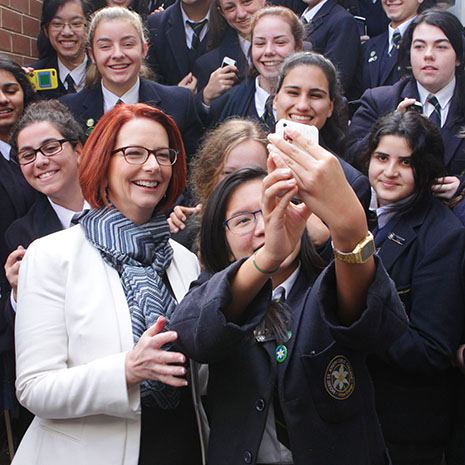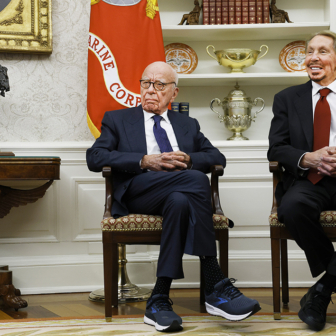He Runs, She Runs:
Why Gender Stereotypes Do Not Harm Women Candidates
By Deborah Jordan Brooks | Princeton University Press | $47.95
The Misogyny Factor
By Anne Summers | NewSouth | $24.99
Unfinished Business: Sex, Freedom and Misogyny
By Anna Goldsworthy | Black Inc. Quarterly Essay | $19.99
The Stalking of Julia Gillard: How the Media and Team Rudd Contrived to Bring Down the Prime Minister
By Kerry-Anne Walsh | Allen and Unwin | $29.99
PUBLIC debate about misogyny in Australian politics peaked in October last year after Julia Gillard let rip in parliament, and it surged again as we came to terms with the fact that our first female prime minister had been booted out of office because of her failure to retain public support. We are left with some troubling questions. Was this a failure on her part, or was it some kind of national failure of political maturity and public intelligence, compounded by low standards of journalistic integrity? To what extent, and in what ways, was misogyny a factor?
In her parting speech on 26 June Gillard made her own pronouncement. “It doesn’t explain everything, it doesn’t explain nothing,” she said. “It explains some things and it is for the nation to think in a sophisticated way about those shades of grey.” In contrast to the personal outburst on the floor of the parliament, the tone was one of stern detachment. The statement was devoid of rhetorical ploys, yet in its balance and economy it carried the hallmarks of classic rhetorical style. Every word hit home. The call for sophistication, for a resistance to ready explanation and all-or-nothing conclusions, suggested that we need to do the accounts but aren’t yet ready to see how they add up. This is unfinished business, but it will take some time to process.
Critical distance melts in the heat of controversy, and some helpful perspectives may be gained by looking at parallel cases in other democracies. Women have been successful heads of government in Ireland, New Zealand, Germany and Britain, though since Margaret Thatcher left office in 1990 there has been no female leader of either major party in Britain and no strong female contenders have emerged. In the United States, the fortunes of Hilary Clinton as a presidential candidate remain the subject of debate. Gillard recently recalled Clinton saying that the gender issue didn’t assume any real intensity when she was a senator; it was when she put herself forward for executive office that the crack in the glass ceiling began to register.
This crucial distinction is acknowledged only in passing by Deborah Jordan Brooks in He Runs, She Runs, a sociological study of voter responses to candidates on the campaign trail in the United States. Brooks sets out to question what she calls the “conventional wisdom” that gender stereotypes make it harder for women to win political office, and although her title suggests a foregone conclusion, her research is broadly based, with some 3000 participants chosen according to rigorous demographic analysis. (Brooks is a former research director for Gallup polling.)
The survey documents voter reactions to a range of behaviours associated with stereotypes of masculine and femininity. On the “feminine” side of the equation, these including crying and other displays of empathy and compassion; on the “masculine” side, anger is the dominant emotional register, together with a tough stance on issues where some form of human loss or suffering may be at issue. Brooks’s results are intriguing: anger tends to have a negative impact, whereas voters are often won over when they see a candidate moved to tears.
In terms of the stereotypical equation, then, “femininity” carries particular advantages, which may outweigh the presumed disadvantage of being a woman candidate. This is a helpful attempt to bring some precision to causal factors that are too often the subject of inflammatory presumptions in public debate. What is missing from He Runs, She Runs, though, is any concerted attempt to factor in how candidates fare in the media. As this figures more prominently in leadership battles, the methodology Brooks adopts can tell us little about the relevance of gender at this level.
TO PURSUE the question of what the misogyny factor does and does not explain in Julia Gillard’s case, we can turn to a spate of offerings from Australian publishers. Jane Caro’s edited collection, Destroying the Joint (a response to one of Alan Jones’s more notorious offensives), was published in May 2013, as was a special issue of the Griffith REVIEW on Women and Power. A fortnight later came Anne Summers’s The Misogyny Factor, which was on prominent display in bookshops – together with the latest Quarterly Essay, Unfinished Business: Sex, Freedom and Misogyny by Anna Goldsworthy, and Kerry-Anne Walsh’s The Stalking of Julia Gillard – during the week Gillard was brought down.
These books have in common the assumption that gender stereotyping is indeed a central political and social issue, and might be open to charges of peddling what Brooks labels “conventional wisdom,’’ but there are entrenched views on both sides of the equation. Suspicion of anyone “playing the gender card” is an equally established convention in Australian politics. Gillard was widely accused of doing this, although she had persistently refused to do so until the “sexism and misogyny” speech left her open to the charge. In a recent interview with Anne Summers, she was more than happy to focus on policy issues about equity and women’s rights at work, but expressed wariness about being the focus herself.
“It was so obvious that I was the first woman to do this job that I didn’t need to hark on about it,” she told Summers. “Every time someone heard me or saw me it was obvious. I didn’t want the story of my prime ministership to be ‘She’s a women, did you realise she’s a woman, has anybody told you she’s a woman?’ you know.”
But what about the prime minister’s own rights at work? This is a question Summers addressed in the University of Newcastle’s Human Rights and Social Justice Lecture in August last year. Available online in R-rated and “vanilla” versions, the lecture provides an anthology of the worst forms of abuse aimed at Gillard. These range from name-calling (Juliar, witch, moll, lying bitch, the red haired bitch, the world’s biggest slut) to suggestions that she should be kicked to death or given a life sentence cleaning toilets. There is also a dismaying gallery of sexualised caricatures. Summers pursues the case in The Misogyny Factor, where she asserts that under the Sex Discrimination Act and the Fair Work Act, Gillard’s rights were comprehensively trashed.
Not everyone is convinced. An article by Summers published in the Sydney Morning Herald the morning after the leadership change drew some 550 comments, more than half of them contemptuous. Politics is a rough trade, and those who engage in it don’t generally appeal to the court of public opinion, or any other court, when they are under attack. The right to insult the national leader is one of the prized freedoms in a democracy – as it has been at least since 1831, when the satirist Charles Philipon defied censorship laws to publish caricatures by Daumier in which the face of King Louis Philippe was distorted into the likeness of a pear. A subsequent image of the king as Gargantua also became a cause célèbre, and editorials in Philipon’s magazine Le Caricature referred to him as “the Fatted Ox,” “the Clown,” the “Ugly Ogre of the System” and “the Crowned Pear.” Grotesque renditions of the ruler’s body and face are part of the satirical tradition Philipon spearheaded, and cartoonists have taken licence accordingly.
Nor are the caricatures of Gillard without precedent in Australian politics. Alexander Downer has been the target of some of the most indecent images. His error of judgement in choosing high-heeled shoes and fishnet tights as costume for an Adelaide charity event in 1996 prompted a continuing array of sexualised portrayals. Stripper, demented cancan dancer, camp schoolboy in short pants, fishnets and lipstick: he is rarely accorded the dignity of appearing fully clothed. A cartoon by David Rowe published in the Sydney Morning Herald on 13 March this year shows him posing naked in a pool of blood, spraying himself with “Afghanis Tan.” How far is too far?
When an Indonesian newspaper attacked a Howard government decision to grant refugee status to forty-two Papuan asylum seekers in March 2006, the accompanying image depicted Howard and Downer as two dingos mating. Howard, in the dominant position, is saying, “I want Papua, Alex!! You try to play it.” Rudd, as shadow foreign affairs minister, said he would raise his concerns about this with the Indonesian ambassador and issued an unequivocal condemnation: “This is a disgusting and disgraceful depiction of the prime minister and the foreign minister, I don’t think it passes any standard of taste anywhere in the world.”
Malcolm Turnbull was equally swift to condemn Alan Jones for the notorious remark that Julia Gillard’s father had “died of shame,” but Tony Abbott has had nothing to say against any of the more graphic forms of vilification aimed at Gillard. If he has standards of taste in these matters, we are yet to hear of them.
In response to Gillard’s “sexism and misogyny” speech, Julie Bishop made a counter-accusation in Abbott’s defence. It was “a vile charge” to call him a misogynist, Bishop said, and the use of the word amounted to a “deliberate and calculated statement that Tony Abbott hates women.” This effectively muddied the waters for a while as journalists went off to check their dictionaries and confirmed to their own satisfaction that, yes, “hatred of women” was an etymologically correct definition of misogyny, then proceeded to relay Bishop’s challenge in interviews with government front benchers. How could you charge Abbott with hatred of women, they asked, when he was, as Bishop affirmed, “a loving son, loving brother, loving husband and loving father”?
A misogynist is not necessarily someone with a personalised hatred of women. Its etymological counterpart (from the ancient Greek) is the word “misanthropist,” which is not generally used in personal terms. A misanthropist bears a deep-seated contempt for mankind. The word “hate” has more personal connotations in our own time than it had in ancient Greece, when it was associated with a fundamental disposition of antipathy, expressed in attitudes of aversion and derision. To deflect the argument onto whether Tony Abbott is being accused of an interpersonal hatred of women is a gesture of wilful obtuseness that no serious political commentator should have bought into.
Misogyny becomes socialised as an antipathy towards women as agents in the world. An individual may have pronounced misogynistic tendencies, but the syndrome is cultural. Summers is concerned with how it plays out as a contempt for the capabilities of women, a tendency to despise everything they say and do. In Unfinished Business, Anna Goldsworthy focuses on the visceral and gynaecological aspects of the problem, charting them on a sliding scale from a relentless focus on appearance through to the trade in pornography.
“Feminism” was a word noticeably absent from the Gillard tirade, Goldsworthy says, though one of the messages of that speech is that “we are not done with feminism yet.” Allowing for the shifts in orientation nominated as first-, second- and third-wave feminism, there has been an ongoing concern with the objectification of women and the relationship of this to cultures of denigration. Goldsworthy explores models of female subjectivity in fantasy and popular culture (from Twilight to Fifty Shades of Gray) that are part of the “war on shame,” before addressing the misogyny debate as a newly inflamed political battlefront, in which Gillard found herself leading a charge in spite of a resolve to focus on her job as prime minister rather than her own identity as a women doing it.
Unfinished Business makes some important points, but recent dramatic turns in the political arena call for something other than a reiteration of feminist arguments. We need to move away from conventional wisdom (or lack of it) on both sides of the argument, and keep in mind Gillard’s own circumspect approach to the equation. It doesn’t explain nothing; it doesn’t explain everything. The question of what is and is not explained by the misogyny factor cannot easily be resolved because in politics it involves an especially difficult judgement, and in Gillard’s case it is bound up with other factors that converged to make her position impossible.
KERRY-ANNE Walsh sets out to track two of these: a hostile media environment, and a relentless sabotage campaign conducted by Kevin Rudd. In her analysis, it is the Rudd factor that predominates. Here, she writes the inverse of the narrative Maxine McKew presented in Tales from the Political Trenches. McKew portrayed Gillard as treacherous, shallow and driven by overweening ambition. In Walsh’s account, Gillard is a stalwart leader assailed by a succession of covert offensives from “team Rudd,” aided by a cabal of journalists.
The Stalking of Julia Gillard is compiled from journal notes and reads accordingly, with frequent interjections: “So – aw shucks – what’s this?” “Hahahahaha. Side splitting!” “Hilarious!” “Well, duh.” “Wow!” To an extent the frustration is understandable, but this is no way to provide an antidote to the calumny she wants to expose. At times the animus against Rudd comes across as simply silly, and distracts from a really important critique of the press gallery’s role. One of the most valuable things in the book is an appendix of hostile stories written by Canberra-based journalists, and often used as the focus for coverage on the SBS and the ABC, where the convention of adversarial interviewing too often slid into a form of white-anting that played to Tony Abbott’s agenda.
Walsh cites, for example, Sabra Lane, chief political correspondent on ABC Radio’s AM, buying into the “sackiversary” propaganda in an interview with Gillard a year after her successful challenge against Rudd. “The opposition has labelled today Assassination Day; one of your colleagues calls it Liberation Day,” says Lane. “Is it a happy anniversary for you?”
On 23 June, the eve of the anniversary, Abbott had moved a censure motion. “This has been the most incompetent, the most deceptive, the most dishonest government in modern Australian history…” it said:
What does this prime minister stand for? She does not stand for telling the truth. She does not stand for standing up for Australia’s national interest. And she does not even stand for honesty in the face of the parliament. Shame on this prime minister.
Twelve months later, there was a repeat performance:
All this prime minister stands for is herself and her ambition…“I have taken control,” she said. Such brazen arrogance – “I have taken control, for precisely that purpose: to get the country back on track.”
She has been a thoroughly incompetent and untrustworthy prime minister. The government had indeed lost its way twelve months ago, but it has got worse – every single day, every single week, every single month – since then, because this prime minister is just not up to the job.
And day after day in parliament, the attack was sustained at this pitch, and in these terms. Gillard was incompetent, presumptuous, dishonest, out of control, an embarrassment. The censure motions came thick and fast.
Reading them in Hansard, I am reminded of a neighbour we had some time ago, who regularly launched into high-decibel tirades against his wife with the opening line, “Ah, yer useless!” After a while, the front door would bang, and he would shout: “That’s right. Run away, why donchya. Run away!” Gillard took to leaving the chamber when Abbott started an attack, and his invective is accordingly peppered with taunts. “This is a prime minister who has not just run away from the people but run away from this parliament,” he said in mid 2010. “This is a prime minister who day after day after day in this House runs away from parliamentary scrutiny.”
Misogyny has its own conventional wisdoms, among which are the conviction that women in general are not to be trusted with any kind of serious responsibility in the world, and that men have the right to harangue them for their faults and failings. It’s here that we approach a broader problem with the conventions of political debate, which were formed in the nineteenth and early twentieth century when Western-style democratic parliaments was almost entirely occupied by men of similar background and education, and the press played a relatively minor role in the electoral stakes.
Attacks of the kind aimed at Gillard might have parallels in some attacks made on male politicians, but the impact is not symmetrical. Gillard herself was extraordinarily resilient, but the spectacle of any woman being so persistently denigrated is troubling in broader social terms. One Facebook site, Julia Gillard, Worst PM in Australia’s History, takes Abbott’s characterisation of her as a starting point for a concentrated hate campaign conducted through photo-shopped images and other forms of iconography, prompting comment lines in which the words “slut,” “whore” and worse are routine.
If Abbott’s censure motions sound a bit too much like domestic abuse, this looks a great deal too much like the kind of cyber-bullying that drives teenagers to suicide. Do we really want this kind of thing to be part of our political culture? If we don’t, we will have to call on both sides of politics to renounce it, and that may mean changing habits of political satire and invective that go back many generations. •




